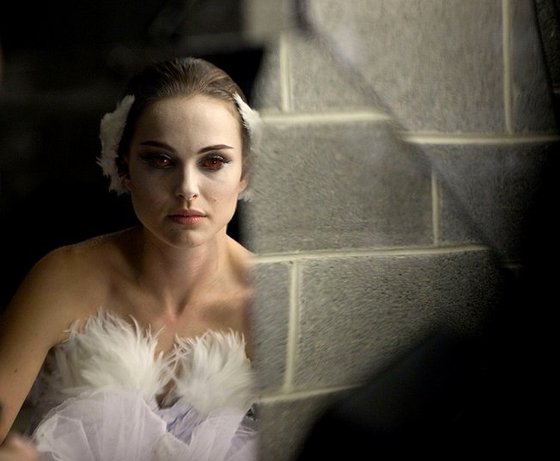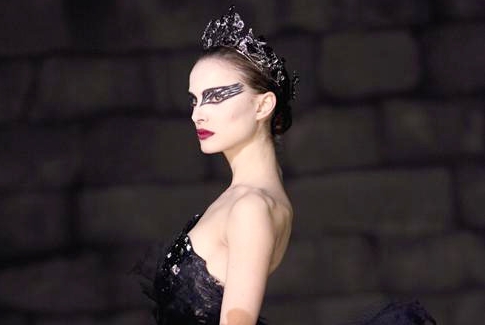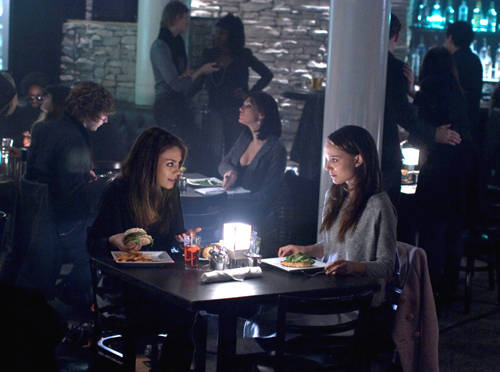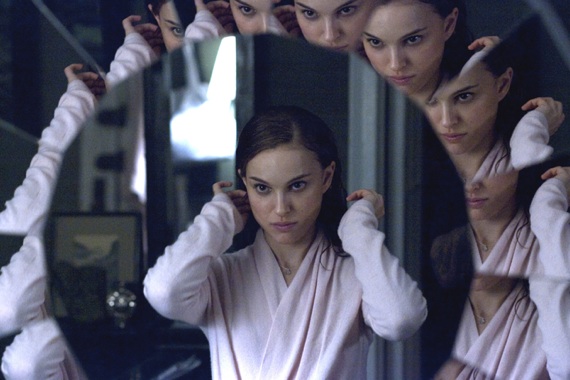Wed 1 Dec 2010
Birds of a Feather
Posted by Ethan under Film Review, NYC Film Critic
[2] Comments
Black Swan
Directed by Darren Aronofsky
Screenplay by Mark Heyman, Andres Heinz, John McLaughlin
Starring Natalie Portman, Mila Kunis, Vincent Cassel and Barbara Hershey
***1/2
The key to appreciating (if not necessarily enjoying) the unnerving ballet psychodrama Black Swan is coming to terms with the fact that director Darren Aronofsky isn’t making Tchaikovsky’s Swan Lake—he’s making Roman Polanski’s Swan Lake. The influence of the controversial Polish filmmaker’s work looms large over this film, particularly his vintage ’60-era thrillers like Rosemary’s Baby, Knife in the Water and Repulsion. Indeed, the latter film is the most obvious influence on Black Swan. Released in 1965, Repulsion (which was Polanski’s first English-language feature) starred Catherine Deneuve as a troubled young woman so frightened of the world in general and men in particular that when her sister leaves her alone in their apartment for a week, her internal demons manifest themselves as terrifying hallucinations that eventually push her over the edge into madness.  Even today, Repulsion remains one of the great “Don’t watch it when you’re home alone†movies, as Polanski turns a nondescript apartment into a cabaret of horrors.
That said, Repulsion can also come across as somewhat silly at times because Polanski pushes the material to extremes in his effort to put the audience in the unhinged mind of its central character. Anyone looking for a realistic depiction of a fractured psyche may have trouble adjusting to Repulsion’s embellishments. The same goes for Black Swan, which is a similarly heightened depiction both of mental illness and sexual repression. Written by a trio of screenwriters that includes Mark Heyman, Andres Heinz and John McLaughlin, the story revolves around Nina Sayers (Natalie Portman), a promising up-and-comer in a New York ballet company headed up by renowned artistic director Thomas Leroy (Vincent Cassel). Leroy plans to open the company’s new season with an edgy version of Swan Lake and hopes to feature a fresh new face in the dual lead role of the White Swan and Black Swan. (For those not familiar with the plot of Swan Lake, the general gist of it is that the beautiful, virtuous White Swan catches the eye of a handsome prince, who is then tricked into romancing her lusty, wanton doppelganger the Black Swan, resulting in much anguish and heartbreak and the White Swan’s eventual suicide.) While the director knows that he has the perfect White Swan in Nina—whose pristine beauty and mastery of technique makes her the company’s best new talent—he’s not certain that she has the wild abandon necessary to dance the part of the Black Swan.
If Leroy knew anything about her home life, he might understand why Nina is so withdrawn and inhibited. Raised in a claustrophobic Upper West Side apartment by an overbearing, overprotective single mother (Barbara Hershey, channeling Piper Laurie from Carrie) who was forced to give up her own ballet career after she got pregnant, the poor girl has been trained to focus on nothing but her dancing career.   Her age may qualify her as an adult, but mentally she’s still very much a sheltered child. That’s why she so desperately desires Leroy’s approval and descends into torment whenever he criticizes her technically perfect, but spiritless dancing. Even after winning the coveted role, Nina can’t be happy—she’s overwhelmed by Leroy’s demands and lives in constant fear of losing the part to another dancer, specifically Lily (Mila Kunis), a tattooed minx who just joined the company after moving to New York from San Francisco. Outgoing, cool and a big hit with the boys (including an obviously infatuated Leroy), Lily is everything Nina isn’t and she views the new arrival with an equal mixture of envy, suspicion and desire.
It’s crucial to the success of Black Swan that the audience is able to experience this heightened reality entirely through Nina’s eyes and Aronofsky does a terrific job trapping the viewer inside her head. Expanding on the visual approach he honed in his previous film, The Wrestler, Aronofsky shoots much of the film (including the ballet sequences) in tight close up with Portman frequently located in the center of the fame, limiting the audience’s field of vision to the environment that’s immediately around her. (In fact, there are only two moments in the movie where we’re allowed to view Nina from a distance, both of which occur in the climactic performance of Swan Lake.) It’s a jarring effect at first; other characters hover around her as almost spectral presences until they enter her line of sight and the locations she passes through blur together as well. Everything about her life seems vaguely unreal, a feeling that increases as the narrative progresses and Nina’s mental state worsens. Suddenly, strange things start to appear around the edges of the frame—paintings on a wall appear to scream at hear and when she gazes at strangers on the street, she sees her own face sneering back at her. Some of these flourishes are a little hoary to be honest, familiar horror movie shocks repurposed here in a somewhat ham-fisted fashion. The same could also be said of the movie’s clichéd presentation of the age-old Madonna/Whore complex, as it once again suggests that the best way for the virginal heroine to improve herself is by embracing her inner slut. (Call it the Grease school of Feminism.) Since the movie was written by three guys and directed by another, it shouldn’t come as a big shock that the tension between the Good Girl (Nina) and the Bad Girl (Lily) eventually leads them into a bedroom encounter sure to be analyzed shot-by-shot on Internet message boards for years to come.
But whatever missteps the films makes along the way are almost completely made up for by its terrific third act, in which Nina finally takes the stage and delivers the performance of her life. Lasting about twenty minutes, this dynamic sequence finds Nina almost completely untethered from reality, possessed by the competing personalities that have taken control of her mind and body. It’s a bravura bit of acting by Portman, who does much of her own dancing, an impressive feat considering that that the Swan Lake performance is filmed in long, unbroken takes unlike the heavily edited dance numbers glimpsed in so many other recent musicals. (Of course, it’s worth noting that Aronofsky’s decision to shoot her largely in close-up and medium shots means that they could have fudged the footwork when it suited them.) Black Swan’s final moments are both profoundly moving and sublimely ridiculous, not unlike the famous farewell number that closes Bob Fosse’s All That Jazz. It’s an extreme depiction of one woman’s unhealthy devotion to her art that’s sometimes easy to laugh at, but ultimately difficult to shake.
Black Swan opens in limited release on Friday, December 3.





Hi,
Natalie Portman did NOT do all her own dancing. That type of skill takes many many years to master! She had not one, but TWO body doubles: Kimberly Prosa and Sarah Lane.
Here’s is a conversation with Kimberly Prosa. I just read this as I am a huge ballet fan.
http://www.dancebloggers.com/2010/11/meet-natalie-portman%e2%80%99s-evil-twin-body-double-kimberly-prosa/
Appreciate the note and the link–have reworded to indicate that Portman did much, but not all of, her dancing.